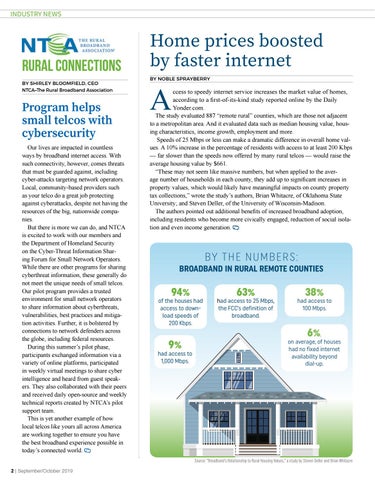INDUSTRY NEWS
Rural Connections BY SHIRLEY BLOOMFIELD, CEO NTCA–The Rural Broadband Association
Program helps small telcos with cybersecurity Our lives are impacted in countless ways by broadband internet access. With such connectivity, however, comes threats that must be guarded against, including cyber-attacks targeting network operators. Local, community-based providers such as your telco do a great job protecting against cyberattacks, despite not having the resources of the big, nationwide companies. But there is more we can do, and NTCA is excited to work with our members and the Department of Homeland Security on the Cyber-Threat Information Sharing Forum for Small Network Operators. While there are other programs for sharing cyberthreat information, these generally do not meet the unique needs of small telcos. Our pilot program provides a trusted environment for small network operators to share information about cyberthreats, vulnerabilities, best practices and mitigation activities. Further, it is bolstered by connections to network defenders across the globe, including federal resources. During this summer’s pilot phase, participants exchanged information via a variety of online platforms, participated in weekly virtual meetings to share cyber intelligence and heard from guest speakers. They also collaborated with their peers and received daily open-source and weekly technical reports created by NTCA’s pilot support team. This is yet another example of how local telcos like yours all across America are working together to ensure you have the best broadband experience possible in today’s connected world.
Home prices boosted by faster internet BY NOBLE SPRAYBERRY
A
ccess to speedy internet service increases the market value of homes, according to a first-of-its-kind study reported online by the Daily Yonder.com. The study evaluated 887 “remote rural” counties, which are those not adjacent to a metropolitan area. And it evaluated data such as median housing value, housing characteristics, income growth, employment and more. Speeds of 25 Mbps or less can make a dramatic difference in overall home values. A 10% increase in the percentage of residents with access to at least 200 Kbps — far slower than the speeds now offered by many rural telcos — would raise the average housing value by $661. “These may not seem like massive numbers, but when applied to the average number of households in each county, they add up to significant increases in property values, which would likely have meaningful impacts on county property tax collections,” wrote the study’s authors, Brian Whitacre, of Oklahoma State University; and Steven Deller, of the University of Wisconsin-Madison. The authors pointed out additional benefits of increased broadband adoption, including residents who become more civically engaged, reduction of social isolation and even income generation.
BY T H E N U MB E R S : BROADBAND IN RURAL REMOTE COUNTIES
94%
of the houses had access to download speeds of 200 Kbps.
9%
had access to 1,000 Mbps.
63%
had access to 25 Mbps, the FCC’s definition of broadband.
38%
had access to 100 Mbps.
6%
, on average, of houses had no fixed internet availability beyond dial-up.
Source: “Broadband’s Relationship to Rural Housing Values,” a study by Steven Deller and Brian Whitacre 2 | September/October 2019




